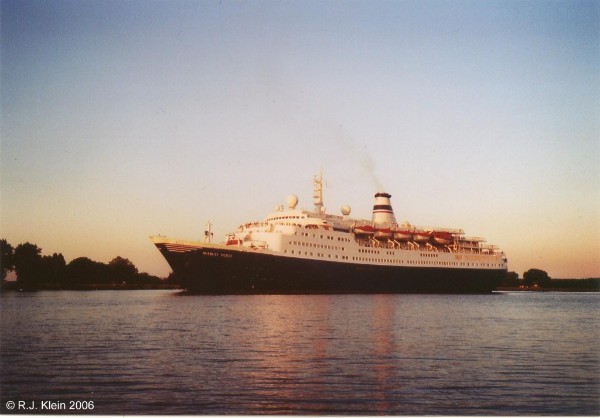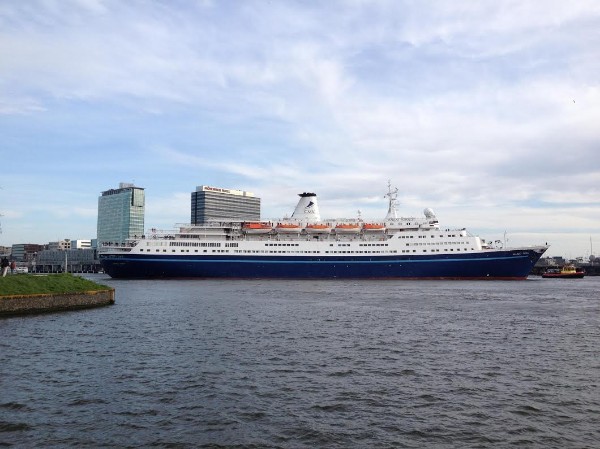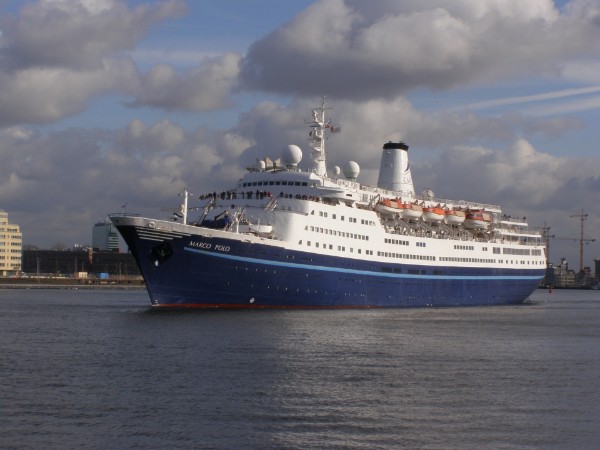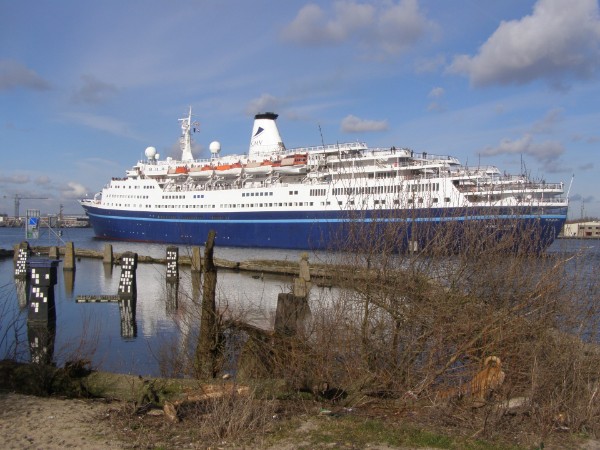Marco Polo

Above, the Marco Polo, now the last survivor of the Sovjet Atlantic fleet and one of the oldest passengerships in the world, sails the Northsea Channel near Buitenhuizen in the summer of 2006. She is seen in the colours of Orient Lines, the company that gave her a new dawn after her Sovjet days.
Background
At the 5th of march 1953, the feared but also loved Sovjet-leader Jozef Stalin died. He was succeeded by Nikita Chroesjtsov, who opposed Stalin's harsh regime, especially over the last years. The new Sovjet-leader was a true communist, but he was also more open then Stalin had been. Under the reign of Chroesjtsjov, the large Sovjet state-fleets for example were expanded, creating the largest passengerfleet in the world in the 1960's. This was in first instance helped by the building of a class of nineteen 5000-ton, 350-passenger ships known as the Mikhail Kalinin-class, after the first ship that was built. The ships were entering service between 1958 and 1964 and were spread out over the several fleets that made up in theory only one, owned by the Sovjet state. The Mikhail Kalinin-class was constructed at the East German VEB Mathias-Thesen Werft at Wismar and they were used as cruiseships in mostly the Black Sea, Mediterranean and the Baltic, although they also served pocket-liner services to ports like London, Stockholm, Helsinki and Le Havre.
In a few years time, the Sovjet state-fleets became the largest passengerfleet in the world, but this also meant that the fleets needed flagships. So in 1960, in the middle of the constructionboom of the class, a 20.000-ton ship was also ordered from the same wharf. This was to be a single-class ship that could be used for real linerservice, but was in fact only used as cruiseship. She entered service in november of 1964 under the name of Ivan Franko. Meanwhile, four sisterships were also ordered, for delivery throughout the 1960's. The ships were spread over two of the State-fleets, Ivan Franko (1964), Taras Shevchenko (1967) and Shota Rustaveli (1968) were built for the Black Sea Shipping Company, homeported in Odessa. Then there also were Alexandr Pushkin (1966) and Mikhail Lermontov (1971), and those were added to the Baltic State Shipping Company fleet with their homeport being Leningrad, the former name of St. Petersburg.
Construction and general statistics
The ship that was to become Marco Polo, started her life under the name of Alexandr Pushkin, the second ship in the class that entered service. All ships of her class were named after famous Russian, Ukrainian and Georgian poets, so the class became know as the poet-class. As said, the ship was constructed at the East-German VEB Mathias Thesen werft at Wismar and she and her sisters were the largest ships constructed in Germany after the second worldwar had ended. Alexandr Pushkin was built under yardnumber 126 and her tonnage-measurement was 19.860. The ship had a lenght of 176,28 meters, she was 23,55 meters wide and her draft reached 8,20 meters. Aboard, she had room for 130 passengers in first class and 620 in the tourist-class, as well as 220 crewmembers. On occasions, also 500 deckpassengers could be ferried on short hauls where no cabins were required. Powered by two seven-cylinder Sulzer-Cegielski designed Diesel-engines and driven by two fixed pitch propellers, she was able to sail at a speed of 20,5 knots.
Alexandr Pushkin was launched at the 26th of march in 1964 and handed over to her owners, the Baltic State Shipping Company, at the 14th of august of 1965. Her homeport was Leningrad (now St.Petersburg) and for her owners, she was the chosen ship to re-open Sovjet transatlantic travel.
Design
As a novelty, all accomodation had seaviews, not only the passengeraccomodation, but also the crews quarters. But don't think it was all luxury, only half of the cabins had private facilities and there were also several cabins for six people, something that was very old-fashioned on newly built cruiseships. Nice to mention is that in the ships cabins, there were three watertaps instead of just two. Next to warm and cold, also seawater could be obtained in the cabins. This was normal in the days before the second worldwar, but in the 1960's it was very uncommon. But the ships did have heated indoor/outdoor swimmingpools with a sliding glass roof overhead that could be opened, so the old-fashioned and the modern were combined within the class. They also were fitted with stabalizers and were fully air-conditioned. Nowadays we take that for granted, but in the middle of the 1960's that wasn't the standard, certainly not on the older liners that were used in the cruise-industry. Because Alexandr Pushkin also had to sail in the northern waters on her route from Leningrad to Montreal, the ship had a ice-strenghtened hull (1C-class) so she would be less furnerable in severe conditions. Aboard she also had two glass-enclosed promenades, a cinema, a library, five bars and a good childrens playroom with even a small roundabout and a dipping pool. Also, normal for those years, the poet-class ships were easily to be converted as troopships when the political climate would require that and the ships cruiserange was to be 10.000 nautical miles before refueling. This also resulted in the fact that the ships of the poet-class had unusually large storage and provision spaces belowdecks, so large amounts of troops could be fed over longer periods of time.
Marco Polo leaving Amsterdam at the 19th of april 2015. This picture was made by and sent to me by Ton van Balen, one of my theater friends.

Alexandr Pushkin's early trans-Atlantic carreer
Alexandr Pushkin, the flagship of the fleet, entered service in august 1965 and reports about her early years are sometimes a little contradictionary. In general, the information is the same, but it can conflict in detail like ports visited or the date of her true beginning as a liner, as transatlantic sailings were a monthly service between april and september only, and she had entered service just at the end of the august of 1965. About this transatlantic scedule, she sailed her first crossing to Montreal at the 13th of april 1966 from Leningrad, that is a certainty. It was the first time that a Sovjet-ship sailed for Canada and the first time since 1909 that a ship belonging to the Sovjet state undertook a transatlantic voyage. Underway, she also called at Helsinki, Copenhagen and Tilbury. For north Atlantic travel she could carry 130 first class pasengers and 620 passengers in tourist class. These crossings were only made during summer, in winter she sailed on cruises for 750 passengers in one class. Where the ship had been sailing between her inauguration and her first transatlantic voyage is not really clear. It is reported that she could have been sailing for Africa as one of the ships of the poet-class seems to have been in Lagos with mostly military personell around this period. It is also said that she was planned to be sailing for the World Youth Festival in Algeria, but because of the military coup there that removed the pro-Sovjet president Ben Bella, this was later cancelled. It seemed that the renewed trans-Atlantic scedule under Sovjet-flag was, although it was the height of the Cold War, promising at least. Especially for Finnish passengers, as the ship was the only sealink between Helsinki and Canada, as well as between Helsinki and London. Also the last ship of the poet-class, Mikhail Lermontov, joined the service from 1971 onwards. But as we know, just during this new decade, airtravel took over very rapidly and from 1979 onwards, Alexandr Pushkin was only sailing cruises. In this last year, because of the Sovjet invasion of Afghanistan, that was not very well recieved in the West to say it lightly, she had to end her Canadian sailings.At that moment, she had been one of just three ships that still sailed regular trans-Atlantic voyages. Next to her, Cunard's Queen Elizabeth 2 and Polish Ocean Lines' Stefan Batory were also in service in 1979.
Cruises had already been a very important part of her early life, in between her trans-Atlantic scedule she undertook many of those, mainly from Tilbury to the West Indies and the Canary Islands, but also from Leningrad in the Baltic Sea and from Havana in the Caribbean. Those were advertised as Russian Style, budget but comfortable and of course with enough caviar, Stroganoff and wodka to fill the inner self. To entertain passengers even more, it also happened that the ship was stopped mid-ocean so they could attent a form of shark-fishing... The British company Royal Mail Lines were the general agents for those UK-based cruises in these years, so it is certainly not the case that the Cold War ended all bonds between the West and the East. For many young Sovjets, it was a way to explore beyond the Iron Curtain while sailing as a crewmember aboard one of those Sovjet ships, for whom there seemed to be not as many borders.
Rebuilding and Australia
Because of growing competition in the British market and her own dated style, the ship was rebuilt in 1975 in Wismar. She recieved several inside cabins and an extended and enlarged main lounge, that became a true two-deck high ballroom. The boat and saloon decks were extended forward to create more space, changing her balanced profile but still she was a handsome ship to see. She now also recieved an outside swimmingpool, and her interiours were refreshed and updated so she should be able to attract more passengers for her cruiseprogram. What was not changed, was that also now not every cabin recieved private bathrooms, many still had to share. Despite her quite thorough rebuilding, the UK passengers started to choose for more modern ships like the first Royal Princess of Princess Cruises that was introduced in 1984. In the UK, the newly created agent CTC Cruises, that was Sovjet-owned by the way, had replaced Royal Mail Lines as the new agents but the older ship was losing passengers every year. From 1981 and 1985 she was chartered to Transocean Tours of Germany and after 1985 her ownership was transferred to the Far Eastern Shipping Company (FESCO), another of the three main Sovjet fleets. During those years, the ship sailed cruises for CTC Cruises around Australia, earning the affectionate nickname 'The Alex'. In Australia, she tried to attract a more youthfull croud that was not so 'demanding' as the UK clientele. Cruising in Australia was, next to the also little old-fashioned Sitmar Line, still in early stages and Alexandr Pushkin's budget cruises were kinda popular, mostly because it was affordable for first-time cruisers.
After her time with Orient Lines ended, the ship came over to the British based CMV Cruises, seen below departing Amsterdam in her new disguise in march 2010.

Changing tides
In 1990, Aleksandr Pushkin was laid up in Singapore. Also Australians were now introduced to more modern ships. The old Sitmar Line had been taken over by P&O and it was expected that more modern ships would be coming over soon. Sitmar had already planned to introduce modern tonnage to Australia, that were to be the largest ships in the world when all had been different. Next to these changes in the industry, that caused Australians to turn their backs to Alexandr Pushkin too, political changes were her final blow. The Sovjet state fell apart around 1990 and the state-owned companies had to re-invent themselves as private firms. This was not easy and all dissappeared over time. The once mighty Sovjet passengerfleet was scattered and the mainly older and more spartan ships needed intensive rebuilding to keep up in the modern cruise-industry. Also for Alexandr Pushkin, the future thus seemed very bleek, although she had been a modern ship for Sovjet standards. All of the ships of her preceeding Mikhail Kalinin-class, that were smaller and less 'modern' but built in the same time-period, were scrapped in the 1990's. Mikhail Lermontov, her last sister, had sank after an collision with rocks in 1986 and her other sisters ended up in mostly budget-style cruising for smaller operators, having a hard time making money for their new owners. In 2003, the last of her sisters still active, the former Shota Rustaveli, was scrapped after unsuccesfull years in Russian charters.
But Alexandr Pushkin had some luck, though. One year after her lay-up, she met up with a man named Gerry Harrod, the former owner of Ocean Cruise Lines, that had been sold to Paquet Cruises of France a little earlier. Harrod saw potential in the old Sovjet lady and he had the ship rebuilt in Greece at the Neorion-wharf in Syros and later at the Perama Shipyard, also in Greece. Rebuilding was overseen by well-known naval architect Knut Hansen and her interiours were designed by Michael and Agni Katzourakis. This work was done between 1991 and 1993 and the ship emerged as the renamed Marco Polo for the newly established Orient Lines. In exteriour, she differed not much from her former Sovjet-service looks, only her funnel was heightened because a new topdeck was installed. Her hull and superstructure were of strong, Sovjet/ German build so nothing was wrong with those, although stabilizers were added to give her soon-to-be passengers a smoother ride. Inside, the ship was stripped totally, modernized and updated, although she was still recognizable as a former ocean liner not loosing her charming classic looks. The only things inside that were not changed, were the dining room, the galleys and the original swimmingpool. Next to all of this, the ships original bell was replaced in the Nansen Card Room. This rebuilding had cost Harrod around 60 million USD and the lenght of the rebuilding as well as the cost prevented him from buying one of the sisterships too. Besides Aleksandr Pushkin, Orient Line was intending to buy the Ivan Franko about the same time as they bought Aleksandr Pushkin, but due to the long and costly rebuilding of the first ship, this eventually did not happen.
New life
The Marco Polo sailed on her first cruise, a lenghty Mombasa to Cape Town journey, in november 1993 and she would sail worldwide varried cruises for her new owner. As seen in her name and that of the company, it was the focus to sail in the Far East and the ship thus was recieving many Asian and Oriental artworks that can still be found aboard today. The company Orient Lines was bought in 1998 by Norwegian Cruise Line but the name of the company and the name of the ship stayed unchanged. In a rebranding strategy in march 2008 though, the Orient Lines brand was discontinued and Marco Polo was sold to the Greece-based company Global Maritime, that chartered the ship out to Transocean Tours, the company where she had already been sailing for during the middle of the 1980's. Her name was not changed and she kept sailing worldwide cruises. Meanwhile, in 2003, her sister Shota Rustaveli (at that time sailing as Assedo) had been sold to the breakers in Alang, India. From that moment on, Marco Polo is the only survivor of the class and the only survivor of the transatlantic service of the Sovjet State fleets. At the end of 2008, Marco Polo started her sailings in charter for the British-based Cruise & Maritime Voyages (CMV) after Transocean Tours had been declared bankrupt. For them, she normally sails European cruises out of Tilbury, England in summer and in winter she sails in more southern seas. For CMV Cruises, she retained her Orient Lines name. It was even so that CMV used her name for a new namingstrategy throughout their growing fleet, as newly aquired ships that entered service in 2015 (Magellan), 2017 (Columbus) and 2019 (Vasco Da Gama), were also named after famous explorers. The middle one, Columbus, was originally ordered by Sitmar Cruises for Australian cruising and she had been in fact one of the ships that had outdated Alexandr Pushkin in Australia in the end of the 1980's, although she in fact never entered service down under.

At the 15th of february 2014, the ship was hit by a freakwave when sailing the English Channel and the wave crashed through the windows of the Waldorf Restaurant, situated on deck 6. According to witnesses, the windows were catapulted into the restaurant like missiles and one 85-year old male passenger was killed instantly. One other 70-year old female passenger had to be airlifted off the ship and was brought to shore for medical treatment. The ship had been hammered by several waves, some of more then 20 meters in height while sailing the Bay of Biscay during the same cruise, but the sad finish was there the day before arrival at Tilbury docks. Repairs were made and the ship was able to sail her next cruise as sceduled.
Not many ships keep sailing in pristine condition up to their fiftieth birthday, but in 2015, Marco Polo hit that magic age. A series of special themed cruises was organized by CMV to celebrate her history. As one of the worlds last former liners and one of the last ships that offers a classic cruise experience, that is exactly what Marco Polo deserves and hopefully she can add many more years in the future.

